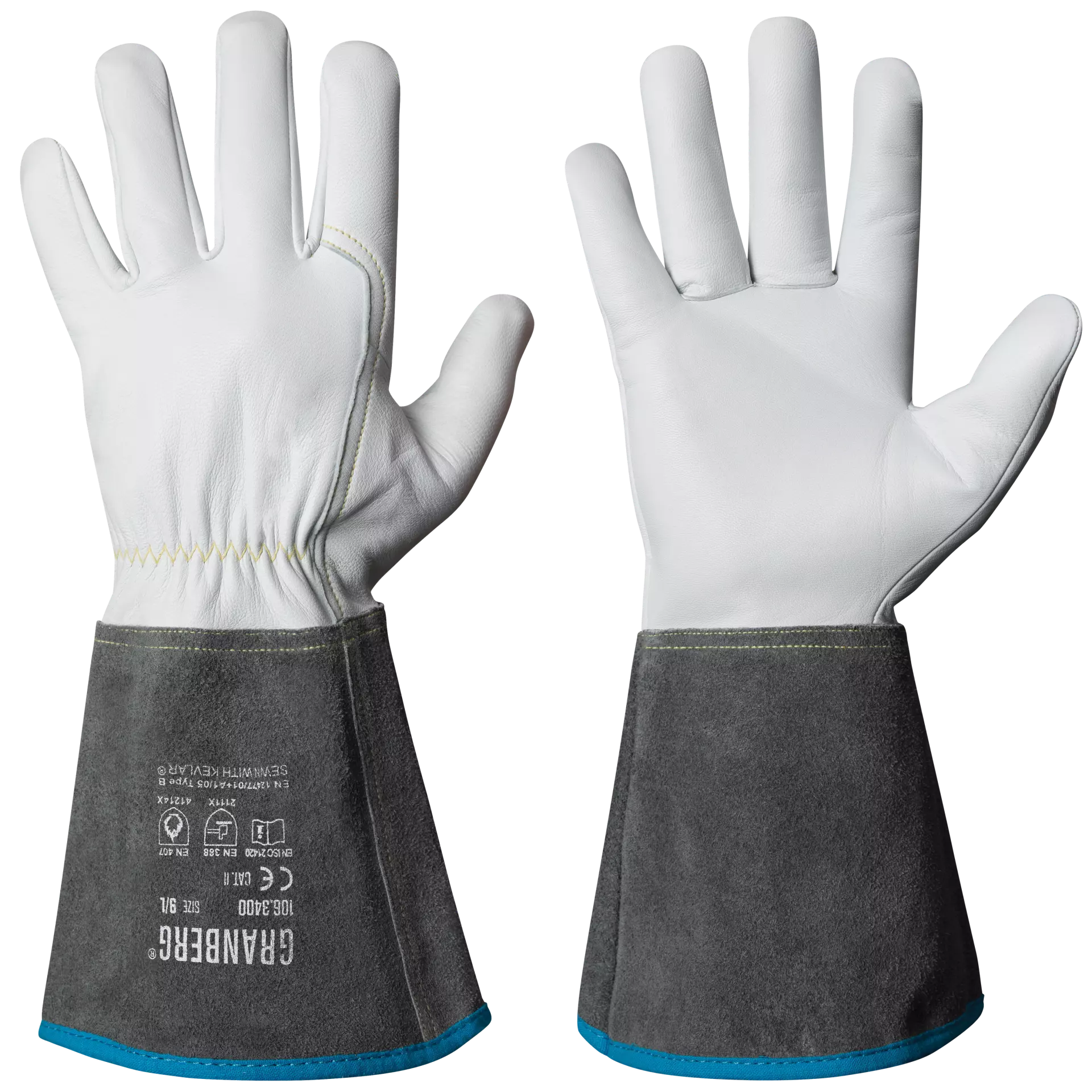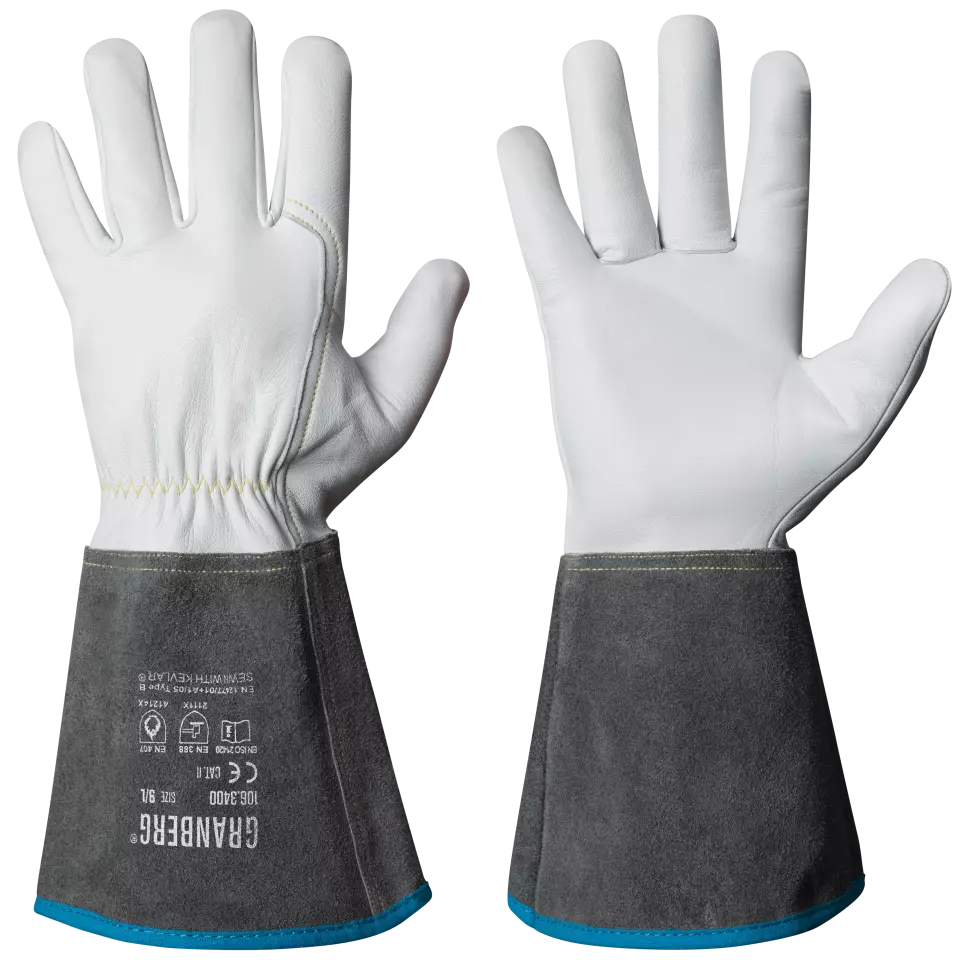
Features You'll Love

Palm Material · Goat leather
The material used on the palm side of the glove, affecting grip, durability, protection level, and comfort during use.

EN 388 · Puncture Resistance Level 1, Abrasion Resistance Level 2, Tear Resistance Level 1
EN 407 · Heat Contact Level 1, Burning Behaviour Level 4, Radiant Heat Level 1, Molten Metal Resistance Level X, Heat Convection Level 2, Metal Splash Resistance Level 4
Provides basic protection against punctures from blunt objects like splinters, not sharp points like needles.
Withstands moderate rubbing and friction, offering good protection for tasks involving handling rough materials.
Provides basic resistance against snagging or catching on rough surfaces, offering minimal protection from tearing.
This product provides short-term protection against contact with hot objects up to 100°C (212°F) for at least 15 seconds. It is ideal for brief handling of warm items in non-professional settings like home kitchens.
Offers the highest protection against catching fire when briefly touching a naked flame. The material resists burning and will extinguish itself almost immediately, giving you crucial time to react and stay safe from burns.
Provides basic protection by delaying heat transfer from a radiant source for at least 7 seconds. This makes it suitable for brief exposure to radiant heat, such as when working near ovens or furnaces from a distance.
This product was not tested for resistance against molten metal splashes under the EN 407 standard. Therefore, it is not intended for use in activities like welding or foundry work where this specific hazard is present.
This product provides moderate protection against convective heat, which is the transfer of heat through moving air or fluids. It is suitable for tasks where you are briefly exposed to hot air, steam, or non-splashing hot liquids.
Offers the highest protection (Level 4) from large splashes of molten metal, withstanding up to 200 grams. This provides critical safety for high-risk jobs like welding or foundry work where significant contact with molten metal is possible.
Granberg
TIG Welding Gloves, Blue/Grey/White, 12 pairs
TIG Welding Gloves, Blue/Grey/White, 12 pairs
5 / 5
124,25 €
Price per 12 pairs
10,35 € / pair
Choose size
Free delivery
Features You'll Love

Palm Material · Goat leather
The material used on the palm side of the glove, affecting grip, durability, protection level, and comfort during use.

EN 388 · Puncture Resistance Level 1, Abrasion Resistance Level 2, Tear Resistance Level 1
EN 407 · Heat Contact Level 1, Burning Behaviour Level 4, Radiant Heat Level 1, Molten Metal Resistance Level X, Heat Convection Level 2, Metal Splash Resistance Level 4
Provides basic protection against punctures from blunt objects like splinters, not sharp points like needles.
Withstands moderate rubbing and friction, offering good protection for tasks involving handling rough materials.
Provides basic resistance against snagging or catching on rough surfaces, offering minimal protection from tearing.
This product provides short-term protection against contact with hot objects up to 100°C (212°F) for at least 15 seconds. It is ideal for brief handling of warm items in non-professional settings like home kitchens.
Offers the highest protection against catching fire when briefly touching a naked flame. The material resists burning and will extinguish itself almost immediately, giving you crucial time to react and stay safe from burns.
Provides basic protection by delaying heat transfer from a radiant source for at least 7 seconds. This makes it suitable for brief exposure to radiant heat, such as when working near ovens or furnaces from a distance.
This product was not tested for resistance against molten metal splashes under the EN 407 standard. Therefore, it is not intended for use in activities like welding or foundry work where this specific hazard is present.
This product provides moderate protection against convective heat, which is the transfer of heat through moving air or fluids. It is suitable for tasks where you are briefly exposed to hot air, steam, or non-splashing hot liquids.
Offers the highest protection (Level 4) from large splashes of molten metal, withstanding up to 200 grams. This provides critical safety for high-risk jobs like welding or foundry work where significant contact with molten metal is possible.
Product description
These premium welding gloves combine high-quality goatskin construction with heat-resistant Kevlar® thread stitching to deliver exceptional protection and durability for demanding welding applications. The innovative design features finger fourchettes for superior dexterity and precision, while the unlined interior maximizes tactile sensitivity. The cow-split leather cuff provides additional comfort and protection during extended use.
Product Features:
- High-quality soft goatskin material for enhanced durability
- Cow-split leather cuff for superior protection
- Finger fourchettes for excellent dexterity and control
- Heat-resistant Kevlar® thread construction
- Unlined design for maximum tactile sensitivity
Technical Details:
- Thickness: 0.7-0.9 mm
- Normal fit
- Dry grip performance
- Materials:
—Back and palm: Goatskin
—Cuff: Cow split leather
Protection Ratings:
- Abrasion resistance: Level 2
- Cut resistance: Level 1
- Tear resistance: Level 1
- Puncture resistance: Level 1
- Limited flame spread: Level 4
- Contact heat: Level 1
- Convective heat: Level 2
- Radiant heat: Level 1
- Small splashes of molten metal: Level 4
Recommended Applications:
- TIG welding
Standards:
- CE Category II
- EN ISO 21420:2020
- EN 12477:2001 Type B
- EN 11492-2